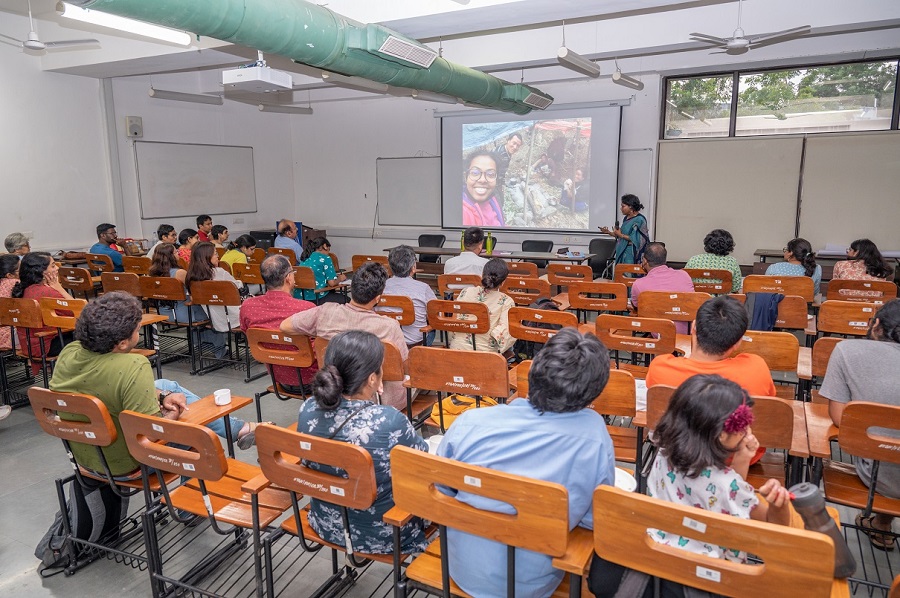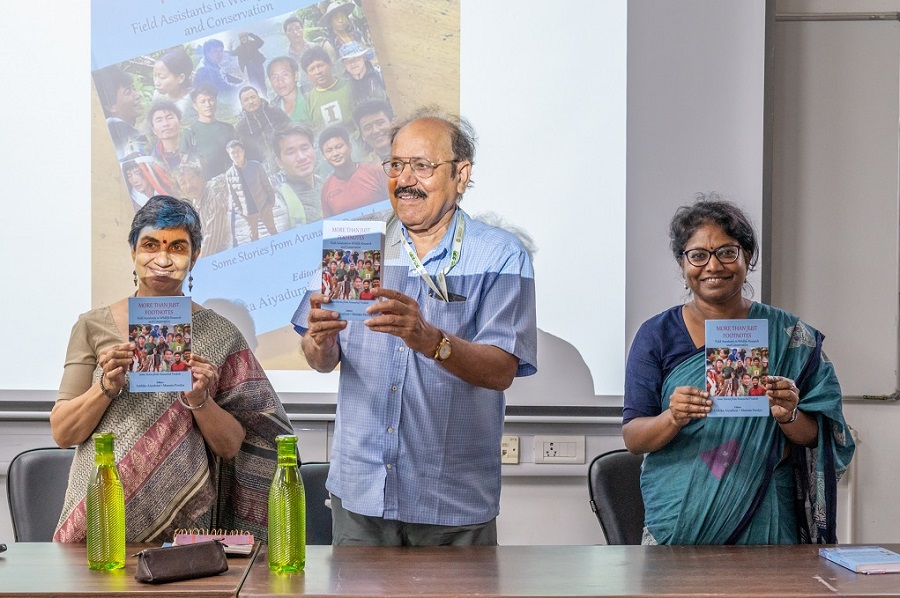STORY CREDITS
Writer/Editor: Shivangi Vasudev Bhatt
Photo: Media and Communication, IIT Gandhinagar
We often look at the sighting of rare species in their natural wildlife habitat with awe and appreciate the work done by the researchers who brought them to the fore. But rarely do people know or talk about the invaluable role played by field assistants in making those sightings and information possible with their indigenous and cultural knowledge. Field assistants are a core part of every field research project whose roles often lie buried as acknowledgements or as footnotes in research publications and documentation.
In an effort to bridge this gap and bring some of these roles onto the main stage, Prof Ambika Aiyadurai, Assistant Professor, Humanities and Social Sciences, IITGN, and Ms Mamata Pandya, Writer and Educator, have collected and co-edited the inspiring stories about field assistants from Arunachal Pradesh in a book titled – “More Than Just Footnotes: Field Assistants in Wildlife Research and Conservation – Some Stories from Arunachal Pradesh”. The book was launched by Dr Asad Rahmani, former director of the Bombay Natural History Society (BNHS) and Chief Guest of the event, along with the co-editors of the book at the Indian Institute of Technology Gandhinagar (IITGN) on August 29, 2023.
The book is a collection of 16 stories written by wildlife biologists, conservation researchers, and forest officers, including six women researchers, who worked in Arunachal Pradesh. These biographical pieces highlight the valuable contributions made by the local assistants in shaping wildlife research and how their inputs have helped in wildlife conservation.
This is one of the most significant books on wildlife field research efforts I have read because not many have written about the contributions of field assistance in their research. I congratulate the authors for thinking about writing and editing this book. Many of the successes of our research are because of the extraordinary local assistance, but we have never thought of giving them their due importance. Hence, this book is a torchbearer of both learning from and educating the local field assistants so that they also benefit in the long run.
Dr Asad Rahmani
Arunachal Pradesh is one of the biodiversity hotspots and has attracted a lot of researchers. Along with the stories of field assistants, the book covers rich information emerging from the state, including research on magnificent wildlife species such as tigers, takin, red panda, frogs, fishes, and gliding squirrels. Field-based wildlife research can be challenging, and therefore, researchers and forest officers often rely on the local communities, who participate in research projects as translators, porters, and guides for identifying animal footprints, counting birds, and fixing camera traps. It is impossible to carry out ecological and social surveys without the tireless support and engagement of field assistants during the process with their valuable knowledge about the landscape, movements of different species, communities’ cultures, and so on. Supported by the National Tiger Conservation Authority (NTCA), the book is considered a first-of-its-kind book in India that exclusively documents the significant role played by the local communities in wildlife research and conservation.
Sharing her field experiences, Prof Ambika Aiyadurai said, “In a landscape like AP, navigating research while tracing wildlife using camera trapping and other tools is possible only because of the knowledge and labour of the field assistants. However, in the typical research and scientific knowledge production, the contributions of these men and women who work with researchers lie buried as acknowledgements or footnotes. In conservation research, the human aspects of the story usually don’t get highlighted. Through this book, the attempt was to highlight the immense contributions of local people by bringing the stories of guidance, friendship, and care that they extend to different researchers in navigating the field.”
Ms Mamata Pandya talked about the process of preparing the book and described her and Dr Aiyadurai’s roles as facilitators of telling the human stories in wildlife conservation.
While briefing about the book, Dr Ambika Aiyadurai gave examples of some of the field assistants from different chapters of the book and how their local knowledge made a difference in various wildlife research projects:
1) Sighting of a Tiger in Snow: Aisho Sharma Adhikarimayum, who is a doctoral scholar at Wildlife Institute of India, in his chapter talks about his field assistant Apiya Jonti Mikhu (or Jonti bhaiya), who suggested Aisho to visit Kahi-po track with him where they saw tiger pugmarks and later according to the suggestions of Jonti Bhaiya, the researchers placed a camera in the area which captured the first recording of a tiger at the highest elevation in the Indian part of Eastern Himalayas.
2) Tracing Red Panda: Rimung Tasso, in her chapter, talks about her experience of working with her field guides Mr Degin Dorji, Pema Chewang (Meymey), and Dechin Saingmo while looking for evidence of Red Panda in Tawang and West Kameng of Arunachal Pradesh. She mentioned how her field guide Mr Dorji, made persistent efforts for three months to sight a Red Panda and also helped her collect scat of Red Panda in the bamboo forest. She also shared that due to the cultural importance of Red Panda among the Monpa community, people have a lot of knowledge about them, and her socialisation and interactions with them helped her learn a lot about Red Panda.
3) Finding Gliding Squirrels at Night: Ecologist Murali Krishnan Chatakonda, in his chapter, talks about the contributions made by his field assistants Biranjoy Basumatary and Erebo Chakma in his work on nocturnal mammal Gliding Squirrels or Flying Squirrels and helped him find them in the field at night.
4) Discovering Frog species: Similarly, Jayanta Kumar Roy, who is a wildlife biologist, has mentioned in his chapter about his visit to the Lower Dibang Valley, where he met his field assistants Regon Menda and Gapo Miuli and later Ahi Mihu in Anini. He shares in the book that the knowledge about forests, cultural practices, and local stories shared by his field assistants had helped him immensely in his research on frogs. Recalling the observation skills of Gapo Miuli and his knowledge of local stories on frogs, Jayanta Kumar has said that it helped him in locating a particular frog called Nanorana Chayuensis and it became a record of sighting this specific species in the state of Arunachal Pradesh.
This news has been covered by some of the leading Indian newspapers and media agencies. Click on the links below to read more.

